Cloud ERP Systems: Advantages, Disadvantages, and Case Study Example
VerifiedAdded on 2023/06/06
|16
|1173
|214
AI Summary
This presentation discusses the integration of cloud computing and ERP software, known as cloud ERP systems. It covers the advantages and disadvantages of this technology, as well as a case study example of its successful implementation. The presentation also highlights the features and benefits of cloud ERP software.
Contribute Materials
Your contribution can guide someone’s learning journey. Share your
documents today.

Cloud ERP Systems
Name of the Student
Name of the University
Name of the Student
Name of the University
Secure Best Marks with AI Grader
Need help grading? Try our AI Grader for instant feedback on your assignments.
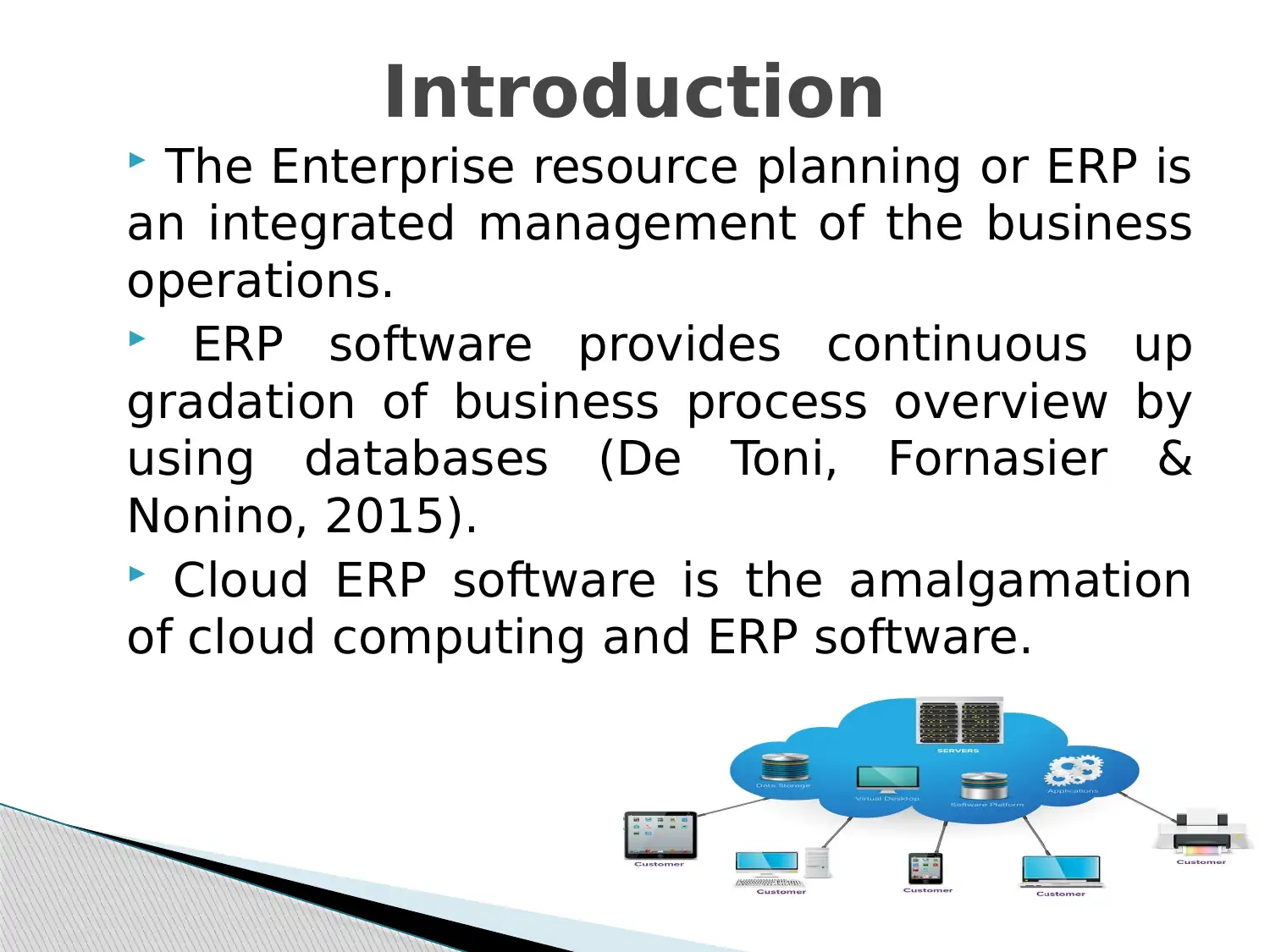
The Enterprise resource planning or ERP is
an integrated management of the business
operations.
ERP software provides continuous up
gradation of business process overview by
using databases (De Toni, Fornasier &
Nonino, 2015).
Cloud ERP software is the amalgamation
of cloud computing and ERP software.
Introduction
an integrated management of the business
operations.
ERP software provides continuous up
gradation of business process overview by
using databases (De Toni, Fornasier &
Nonino, 2015).
Cloud ERP software is the amalgamation
of cloud computing and ERP software.
Introduction
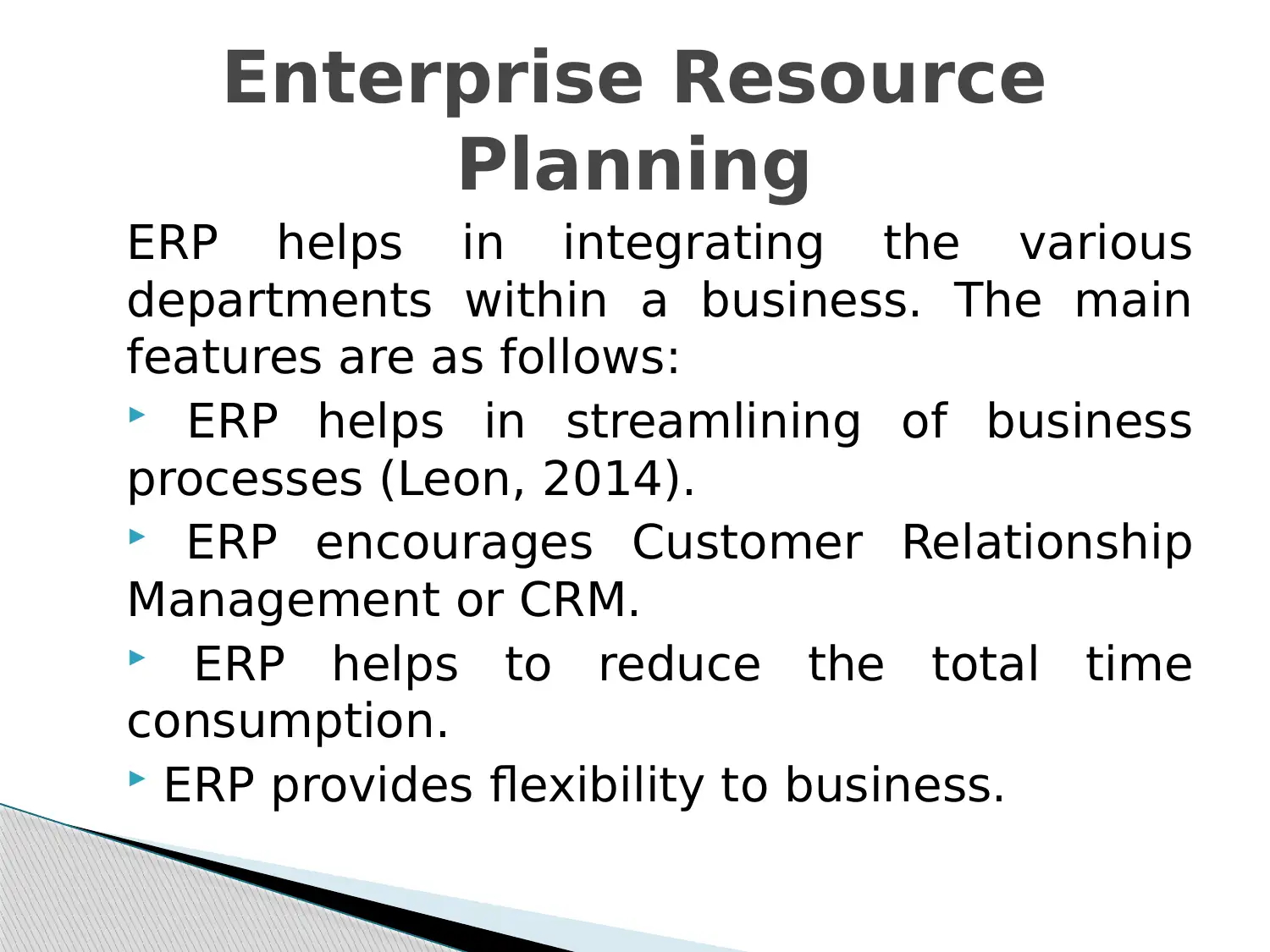
ERP helps in integrating the various
departments within a business. The main
features are as follows:
ERP helps in streamlining of business
processes (Leon, 2014).
ERP encourages Customer Relationship
Management or CRM.
ERP helps to reduce the total time
consumption.
ERP provides flexibility to business.
Enterprise Resource
Planning
departments within a business. The main
features are as follows:
ERP helps in streamlining of business
processes (Leon, 2014).
ERP encourages Customer Relationship
Management or CRM.
ERP helps to reduce the total time
consumption.
ERP provides flexibility to business.
Enterprise Resource
Planning

The major advantages of ERP are as follows:
Better Efficiency: ERP helps to provide
better efficiency.
Competitive Advantages: ERP helps to
provide competitive advantages to the
business (Yeh & Xu, 2013).
Cost Effectiveness: ERP is extremely
cost effective.
High Collaboration: This software
provides better collaboration to the
business.
Advantages of ERP
Better Efficiency: ERP helps to provide
better efficiency.
Competitive Advantages: ERP helps to
provide competitive advantages to the
business (Yeh & Xu, 2013).
Cost Effectiveness: ERP is extremely
cost effective.
High Collaboration: This software
provides better collaboration to the
business.
Advantages of ERP
Secure Best Marks with AI Grader
Need help grading? Try our AI Grader for instant feedback on your assignments.

The major disadvantages of this ERP are as
follows:
Data Migration: The migration of service
and data is difficult.
Lack of Security: There is lack of
security to the data (Chofreh et al., 2014).
High Indirect Costs: The indirect costs of
this software is extremely high.
Disadvantages of ERP
follows:
Data Migration: The migration of service
and data is difficult.
Lack of Security: There is lack of
security to the data (Chofreh et al., 2014).
High Indirect Costs: The indirect costs of
this software is extremely high.
Disadvantages of ERP
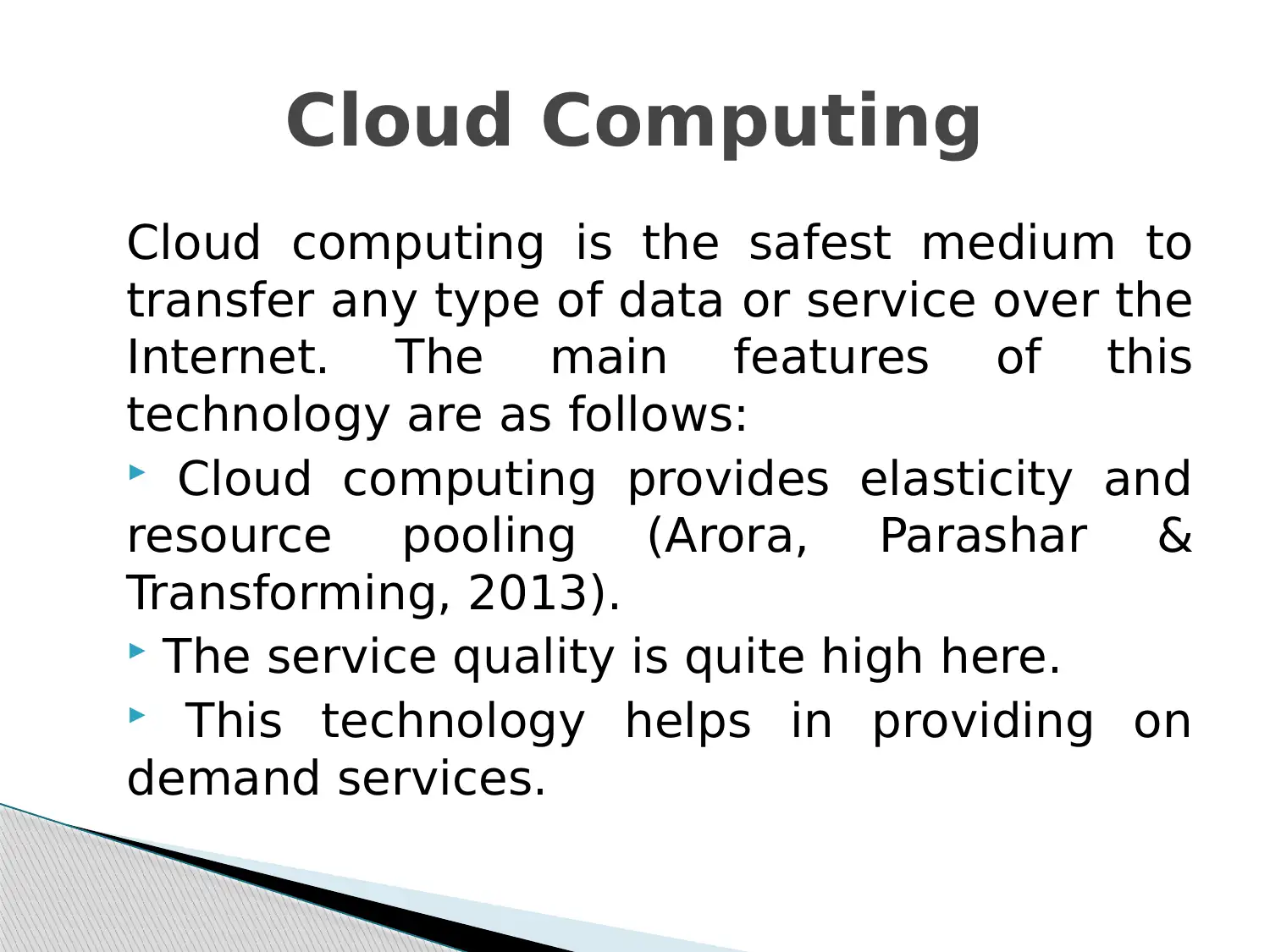
Cloud computing is the safest medium to
transfer any type of data or service over the
Internet. The main features of this
technology are as follows:
Cloud computing provides elasticity and
resource pooling (Arora, Parashar &
Transforming, 2013).
The service quality is quite high here.
This technology helps in providing on
demand services.
Cloud Computing
transfer any type of data or service over the
Internet. The main features of this
technology are as follows:
Cloud computing provides elasticity and
resource pooling (Arora, Parashar &
Transforming, 2013).
The service quality is quite high here.
This technology helps in providing on
demand services.
Cloud Computing
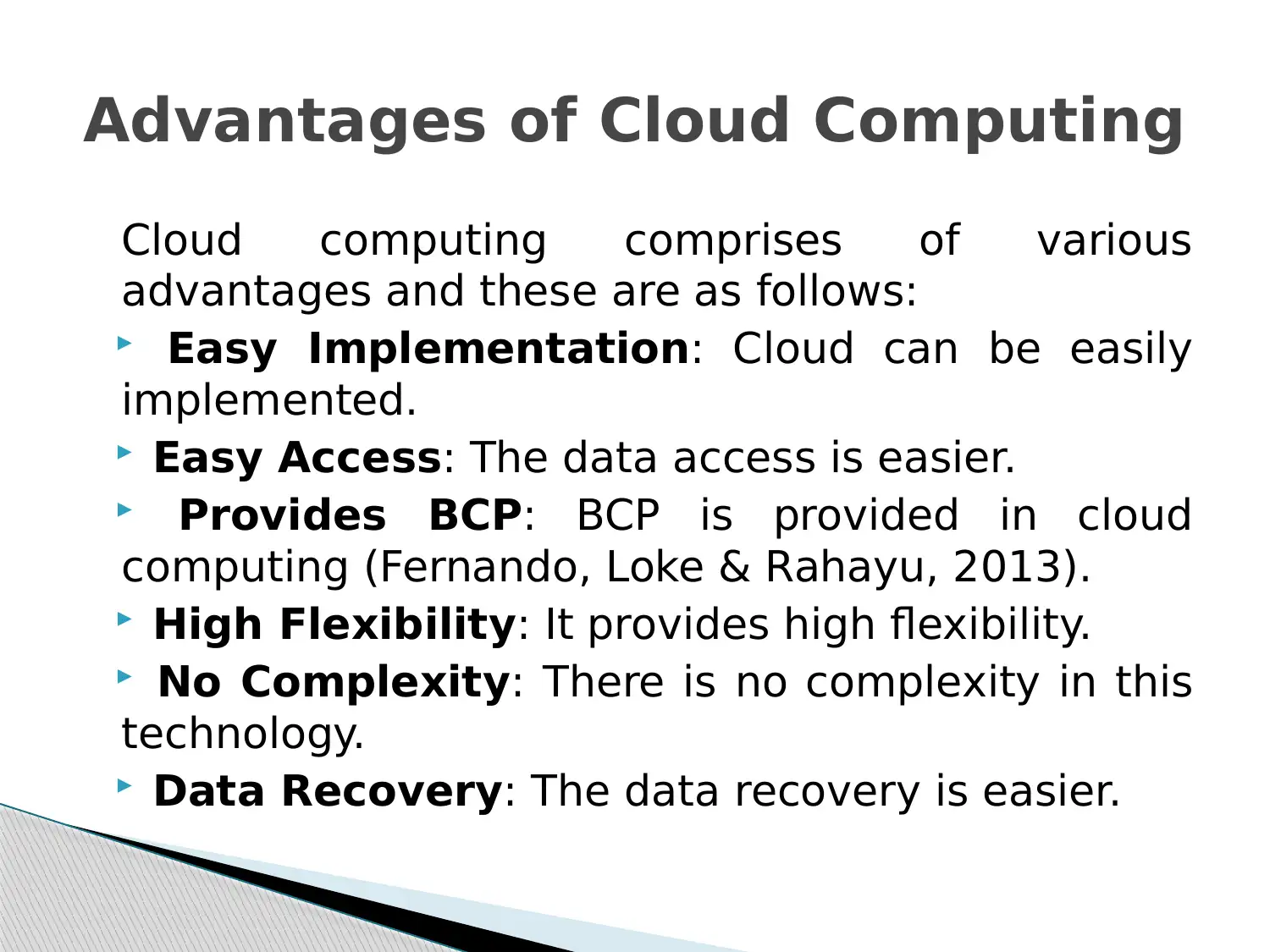
Cloud computing comprises of various
advantages and these are as follows:
Easy Implementation: Cloud can be easily
implemented.
Easy Access: The data access is easier.
Provides BCP: BCP is provided in cloud
computing (Fernando, Loke & Rahayu, 2013).
High Flexibility: It provides high flexibility.
No Complexity: There is no complexity in this
technology.
Data Recovery: The data recovery is easier.
Advantages of Cloud Computing
advantages and these are as follows:
Easy Implementation: Cloud can be easily
implemented.
Easy Access: The data access is easier.
Provides BCP: BCP is provided in cloud
computing (Fernando, Loke & Rahayu, 2013).
High Flexibility: It provides high flexibility.
No Complexity: There is no complexity in this
technology.
Data Recovery: The data recovery is easier.
Advantages of Cloud Computing
Paraphrase This Document
Need a fresh take? Get an instant paraphrase of this document with our AI Paraphraser
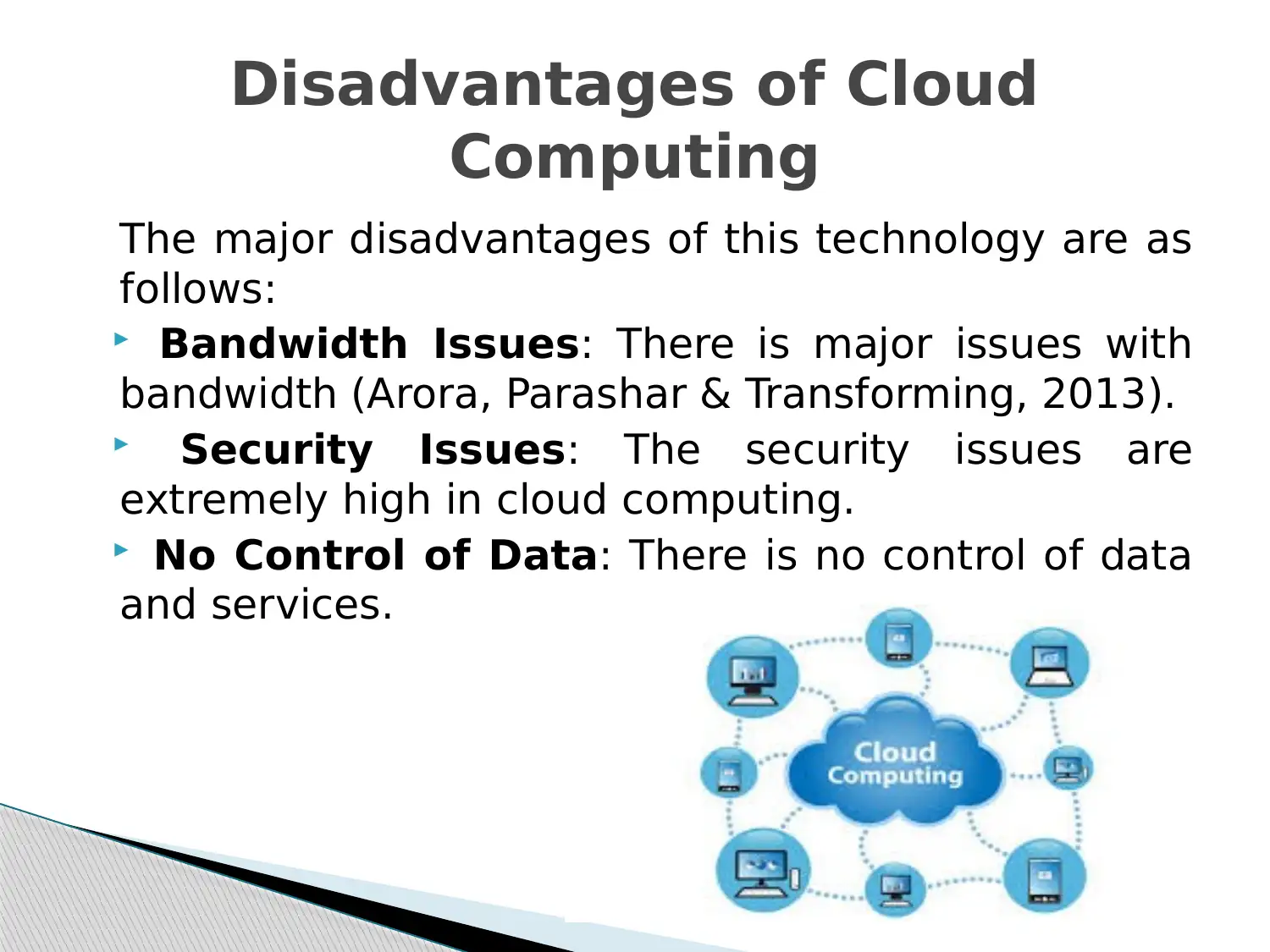
The major disadvantages of this technology are as
follows:
Bandwidth Issues: There is major issues with
bandwidth (Arora, Parashar & Transforming, 2013).
Security Issues: The security issues are
extremely high in cloud computing.
No Control of Data: There is no control of data
and services.
Disadvantages of Cloud
Computing
follows:
Bandwidth Issues: There is major issues with
bandwidth (Arora, Parashar & Transforming, 2013).
Security Issues: The security issues are
extremely high in cloud computing.
No Control of Data: There is no control of data
and services.
Disadvantages of Cloud
Computing
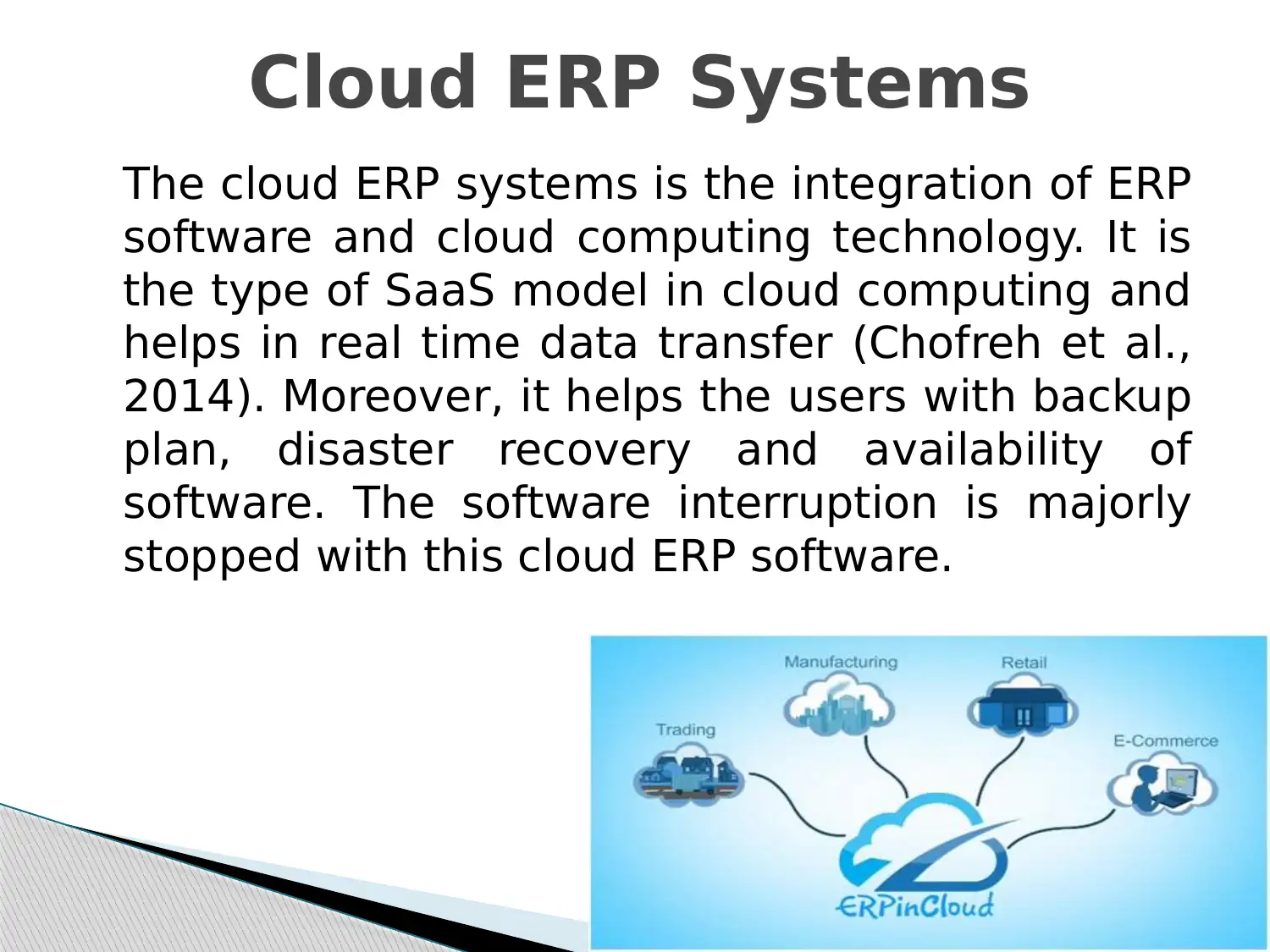
The cloud ERP systems is the integration of ERP
software and cloud computing technology. It is
the type of SaaS model in cloud computing and
helps in real time data transfer (Chofreh et al.,
2014). Moreover, it helps the users with backup
plan, disaster recovery and availability of
software. The software interruption is majorly
stopped with this cloud ERP software.
Cloud ERP Systems
software and cloud computing technology. It is
the type of SaaS model in cloud computing and
helps in real time data transfer (Chofreh et al.,
2014). Moreover, it helps the users with backup
plan, disaster recovery and availability of
software. The software interruption is majorly
stopped with this cloud ERP software.
Cloud ERP Systems
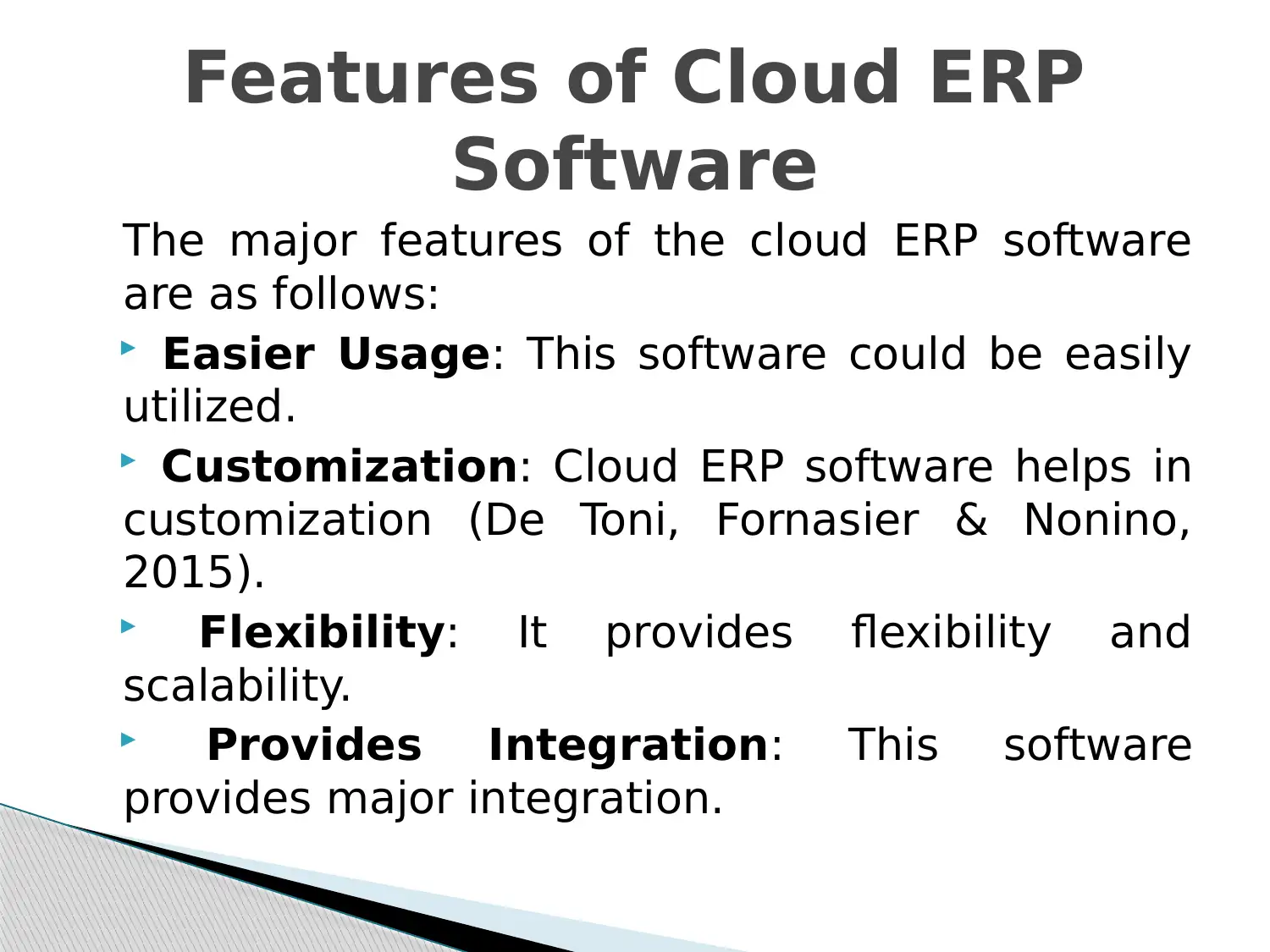
The major features of the cloud ERP software
are as follows:
Easier Usage: This software could be easily
utilized.
Customization: Cloud ERP software helps in
customization (De Toni, Fornasier & Nonino,
2015).
Flexibility: It provides flexibility and
scalability.
Provides Integration: This software
provides major integration.
Features of Cloud ERP
Software
are as follows:
Easier Usage: This software could be easily
utilized.
Customization: Cloud ERP software helps in
customization (De Toni, Fornasier & Nonino,
2015).
Flexibility: It provides flexibility and
scalability.
Provides Integration: This software
provides major integration.
Features of Cloud ERP
Software
Secure Best Marks with AI Grader
Need help grading? Try our AI Grader for instant feedback on your assignments.
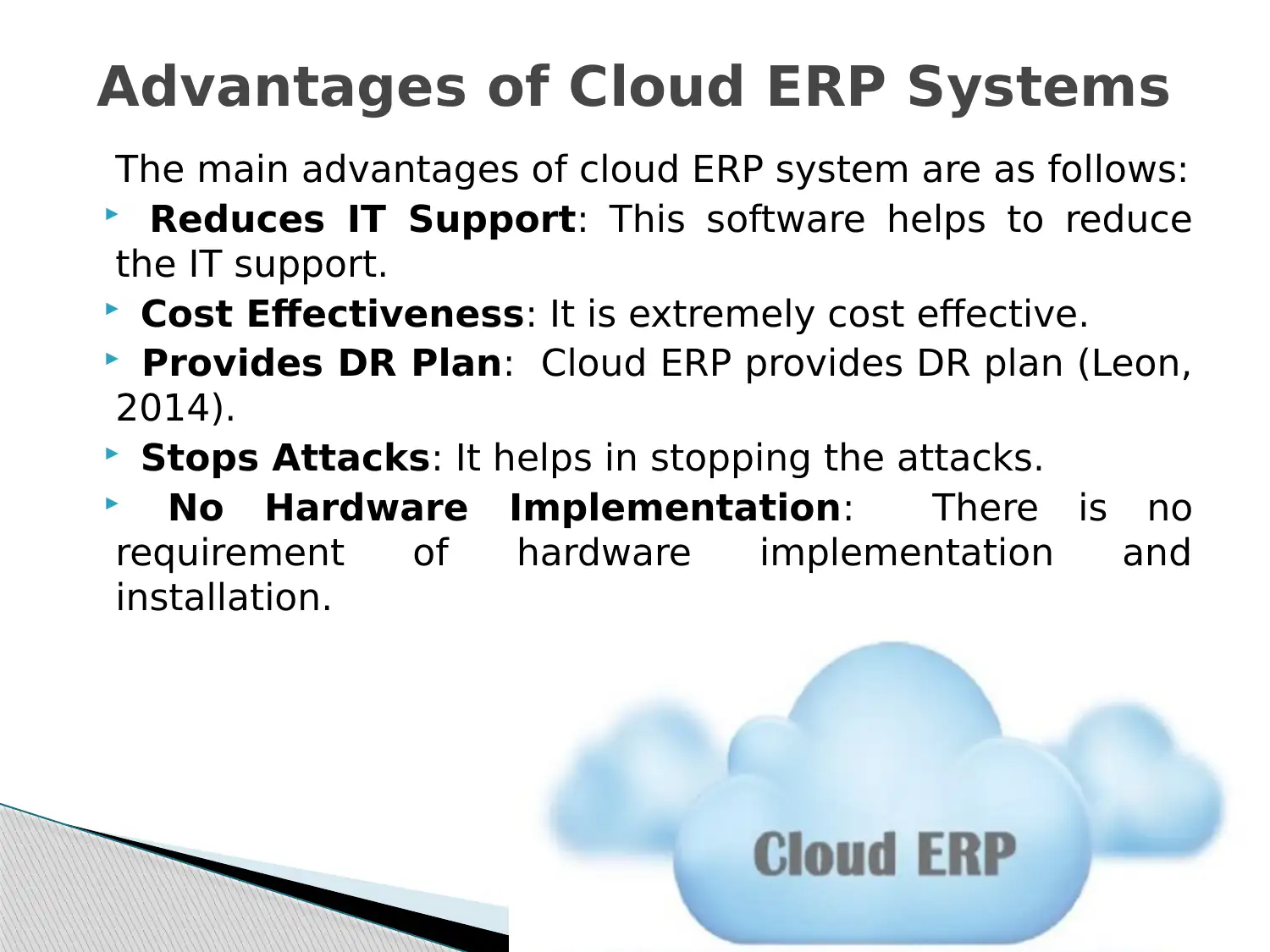
The main advantages of cloud ERP system are as follows:
Reduces IT Support: This software helps to reduce
the IT support.
Cost Effectiveness: It is extremely cost effective.
Provides DR Plan: Cloud ERP provides DR plan (Leon,
2014).
Stops Attacks: It helps in stopping the attacks.
No Hardware Implementation: There is no
requirement of hardware implementation and
installation.
Advantages of Cloud ERP Systems
Reduces IT Support: This software helps to reduce
the IT support.
Cost Effectiveness: It is extremely cost effective.
Provides DR Plan: Cloud ERP provides DR plan (Leon,
2014).
Stops Attacks: It helps in stopping the attacks.
No Hardware Implementation: There is no
requirement of hardware implementation and
installation.
Advantages of Cloud ERP Systems
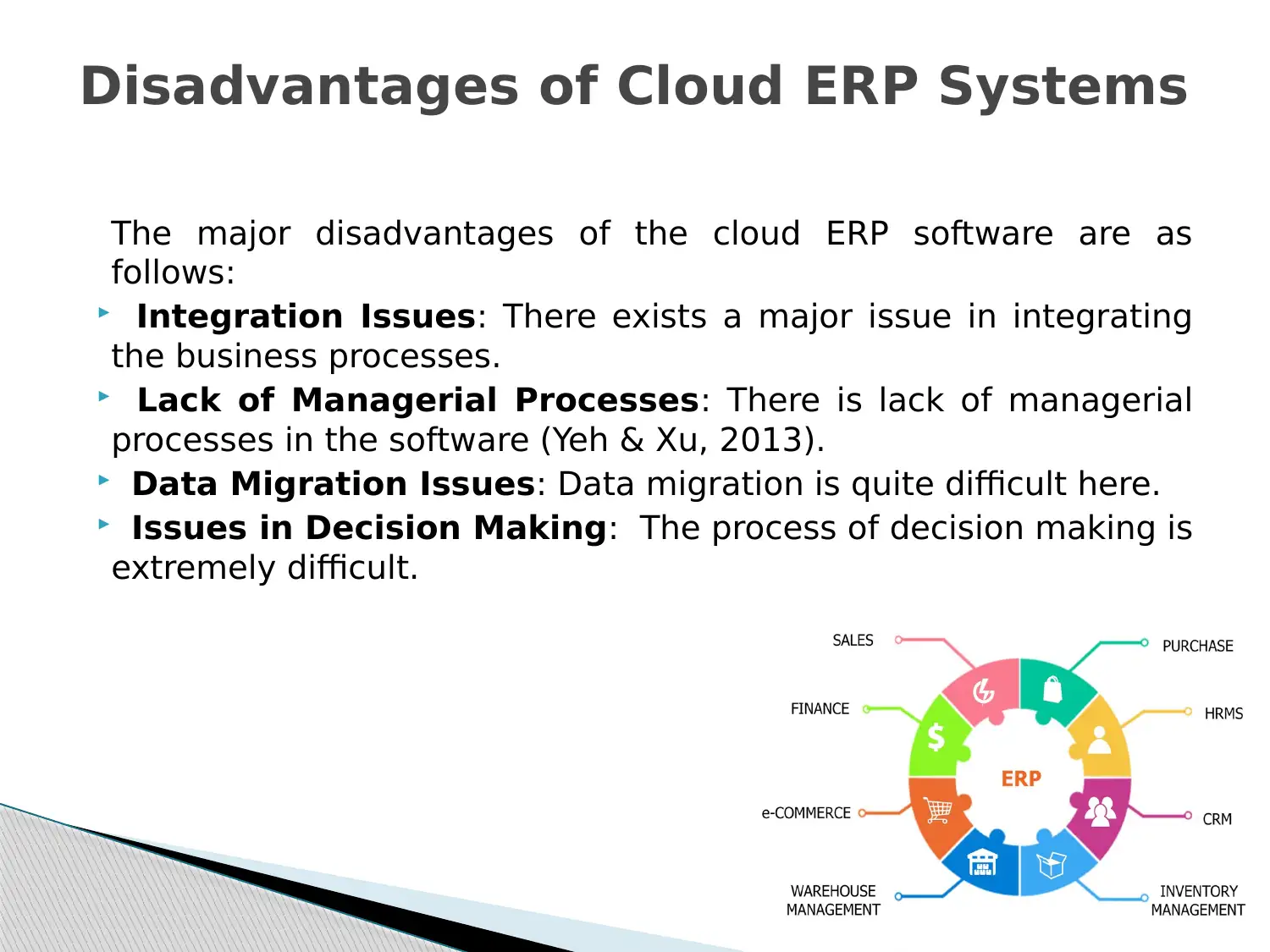
The major disadvantages of the cloud ERP software are as
follows:
Integration Issues: There exists a major issue in integrating
the business processes.
Lack of Managerial Processes: There is lack of managerial
processes in the software (Yeh & Xu, 2013).
Data Migration Issues: Data migration is quite difficult here.
Issues in Decision Making: The process of decision making is
extremely difficult.
Disadvantages of Cloud ERP Systems
follows:
Integration Issues: There exists a major issue in integrating
the business processes.
Lack of Managerial Processes: There is lack of managerial
processes in the software (Yeh & Xu, 2013).
Data Migration Issues: Data migration is quite difficult here.
Issues in Decision Making: The process of decision making is
extremely difficult.
Disadvantages of Cloud ERP Systems
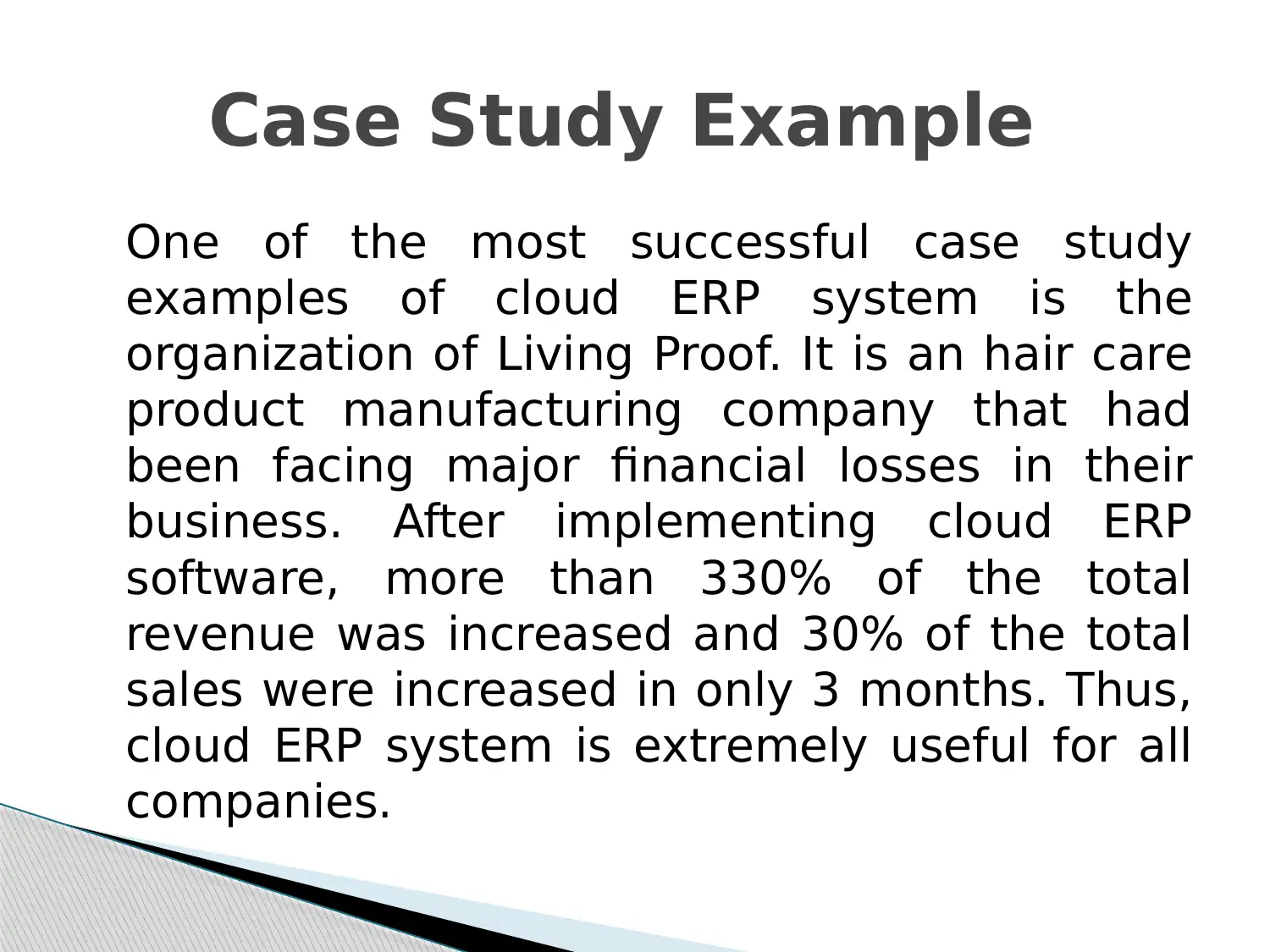
One of the most successful case study
examples of cloud ERP system is the
organization of Living Proof. It is an hair care
product manufacturing company that had
been facing major financial losses in their
business. After implementing cloud ERP
software, more than 330% of the total
revenue was increased and 30% of the total
sales were increased in only 3 months. Thus,
cloud ERP system is extremely useful for all
companies.
Case Study Example
examples of cloud ERP system is the
organization of Living Proof. It is an hair care
product manufacturing company that had
been facing major financial losses in their
business. After implementing cloud ERP
software, more than 330% of the total
revenue was increased and 30% of the total
sales were increased in only 3 months. Thus,
cloud ERP system is extremely useful for all
companies.
Case Study Example
Paraphrase This Document
Need a fresh take? Get an instant paraphrase of this document with our AI Paraphraser
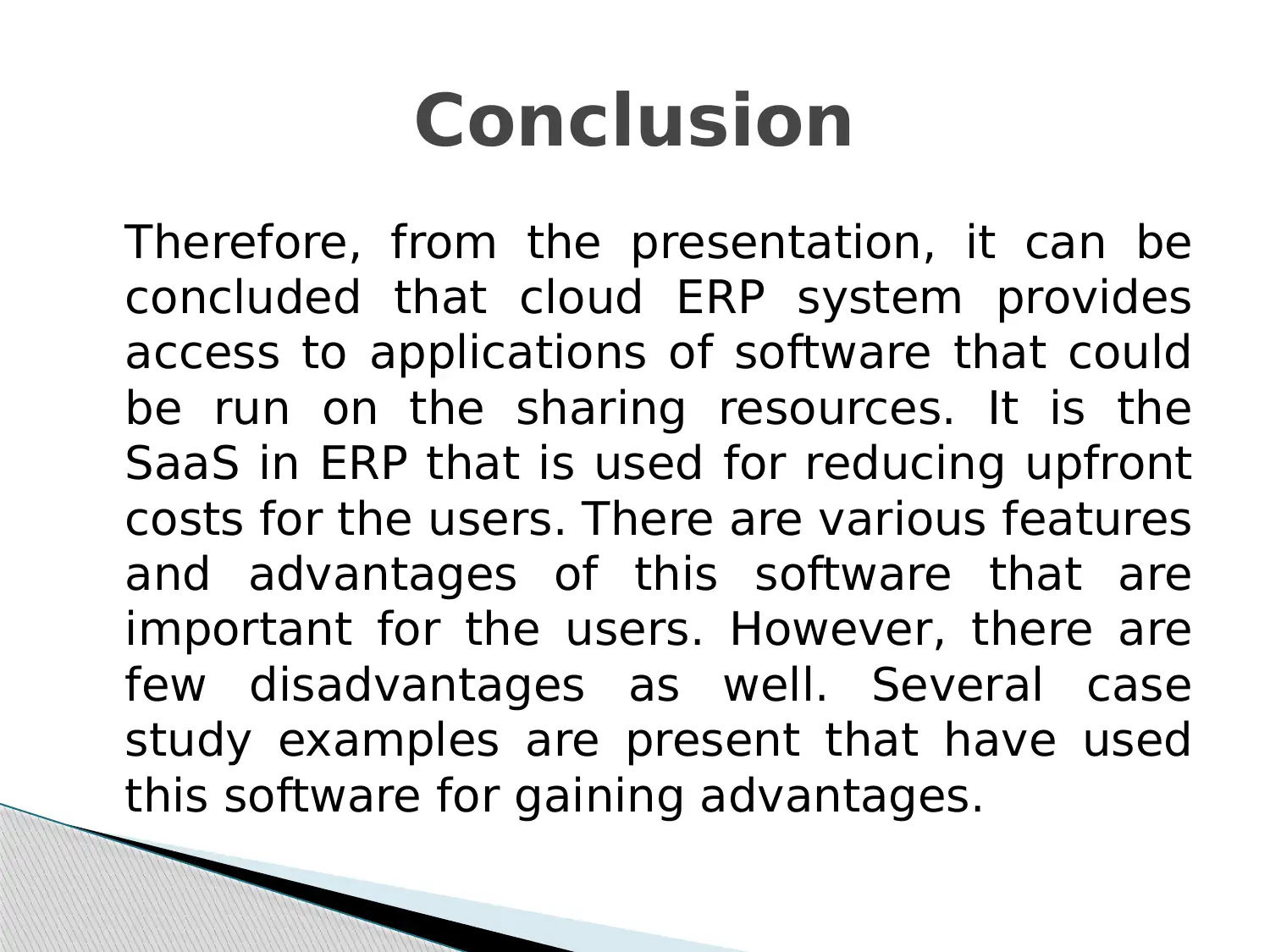
Therefore, from the presentation, it can be
concluded that cloud ERP system provides
access to applications of software that could
be run on the sharing resources. It is the
SaaS in ERP that is used for reducing upfront
costs for the users. There are various features
and advantages of this software that are
important for the users. However, there are
few disadvantages as well. Several case
study examples are present that have used
this software for gaining advantages.
Conclusion
concluded that cloud ERP system provides
access to applications of software that could
be run on the sharing resources. It is the
SaaS in ERP that is used for reducing upfront
costs for the users. There are various features
and advantages of this software that are
important for the users. However, there are
few disadvantages as well. Several case
study examples are present that have used
this software for gaining advantages.
Conclusion
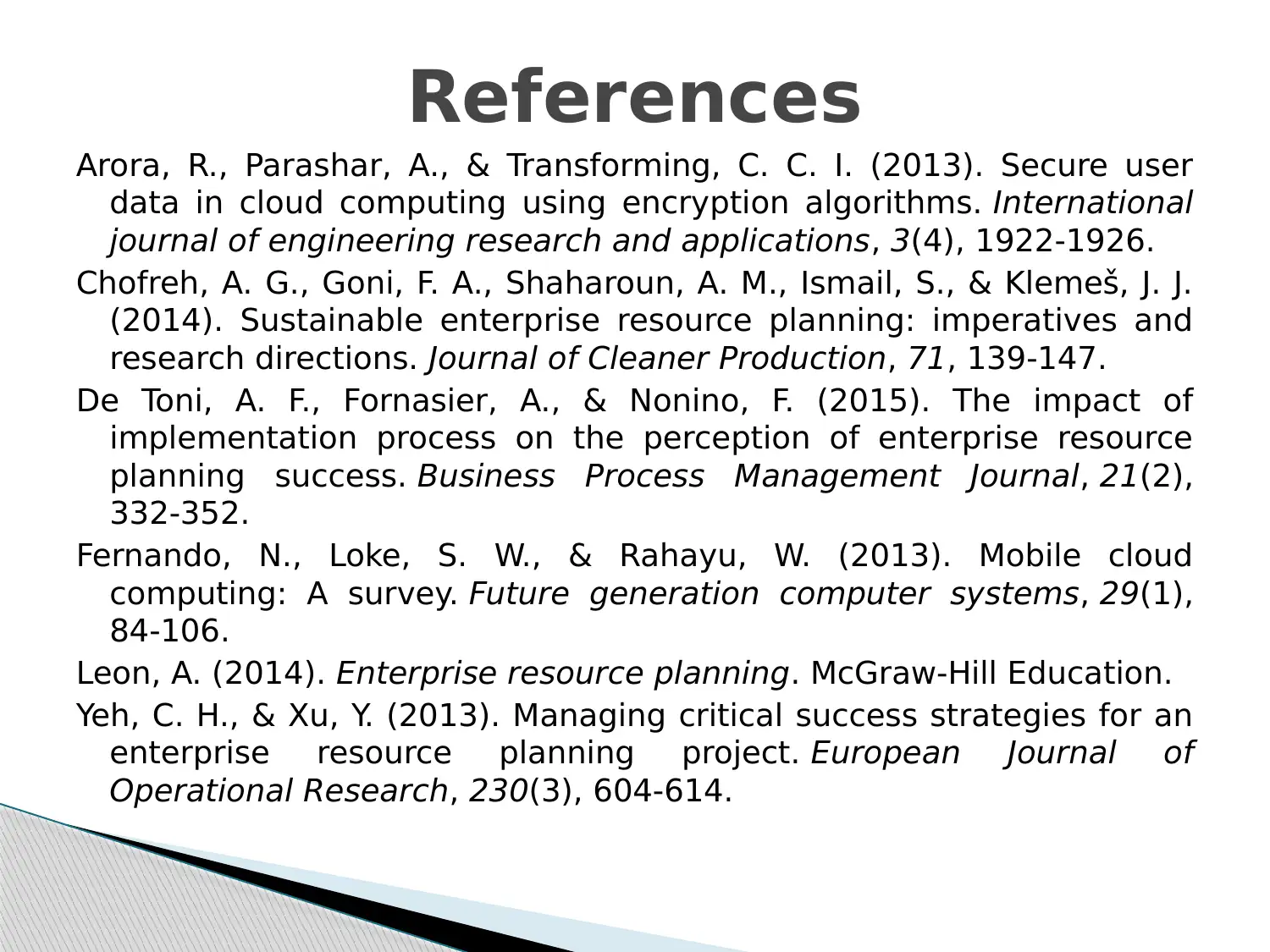
Arora, R., Parashar, A., & Transforming, C. C. I. (2013). Secure user
data in cloud computing using encryption algorithms. International
journal of engineering research and applications, 3(4), 1922-1926.
Chofreh, A. G., Goni, F. A., Shaharoun, A. M., Ismail, S., & Klemeš, J. J.
(2014). Sustainable enterprise resource planning: imperatives and
research directions. Journal of Cleaner Production, 71, 139-147.
De Toni, A. F., Fornasier, A., & Nonino, F. (2015). The impact of
implementation process on the perception of enterprise resource
planning success. Business Process Management Journal, 21(2),
332-352.
Fernando, N., Loke, S. W., & Rahayu, W. (2013). Mobile cloud
computing: A survey. Future generation computer systems, 29(1),
84-106.
Leon, A. (2014). Enterprise resource planning. McGraw-Hill Education.
Yeh, C. H., & Xu, Y. (2013). Managing critical success strategies for an
enterprise resource planning project. European Journal of
Operational Research, 230(3), 604-614.
References
data in cloud computing using encryption algorithms. International
journal of engineering research and applications, 3(4), 1922-1926.
Chofreh, A. G., Goni, F. A., Shaharoun, A. M., Ismail, S., & Klemeš, J. J.
(2014). Sustainable enterprise resource planning: imperatives and
research directions. Journal of Cleaner Production, 71, 139-147.
De Toni, A. F., Fornasier, A., & Nonino, F. (2015). The impact of
implementation process on the perception of enterprise resource
planning success. Business Process Management Journal, 21(2),
332-352.
Fernando, N., Loke, S. W., & Rahayu, W. (2013). Mobile cloud
computing: A survey. Future generation computer systems, 29(1),
84-106.
Leon, A. (2014). Enterprise resource planning. McGraw-Hill Education.
Yeh, C. H., & Xu, Y. (2013). Managing critical success strategies for an
enterprise resource planning project. European Journal of
Operational Research, 230(3), 604-614.
References

1 out of 16
Related Documents
Your All-in-One AI-Powered Toolkit for Academic Success.
+13062052269
info@desklib.com
Available 24*7 on WhatsApp / Email
![[object Object]](/_next/static/media/star-bottom.7253800d.svg)
Unlock your academic potential
© 2024 | Zucol Services PVT LTD | All rights reserved.




